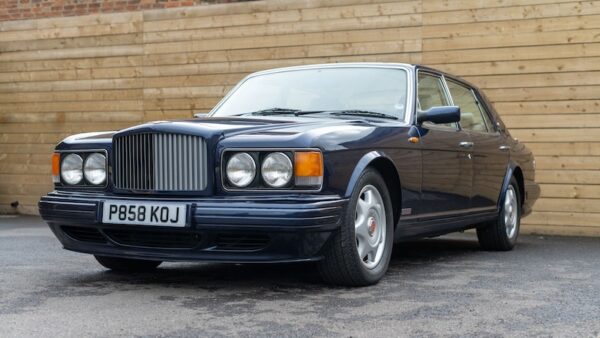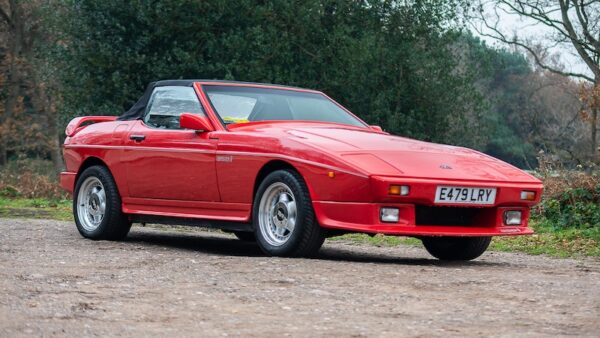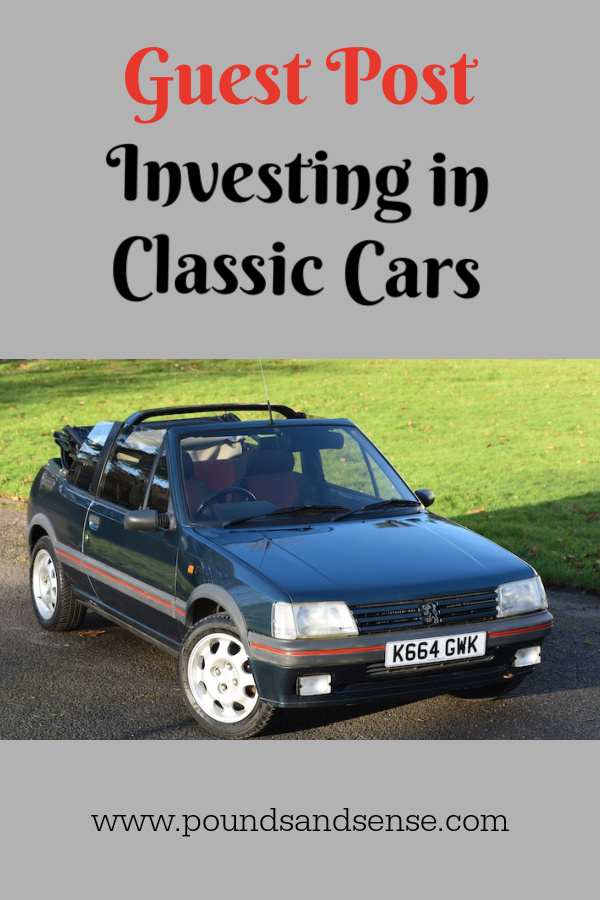Guest Post: Investing in Classic Cars
Today I am pleased to bring you a guest post on investing in classic cars, a subject which I freely admit I previously knew little about. The article comes from my friends at the popular Car & Classic website.
As they say at Car & Classic, not all collectable metal is gold…
More than ever, nowadays, investors may be on the lookout for sensible use of their cash; there are relatively higher interest rate savings accounts, granted, alongside the usual route to gold and fine art. Even wines appreciate in time, if the right bottles are purchased, and kept untouched.
However, unlike paintings, gold and building society accounts, there is an area of investment which can be actively enjoyed whilst the asset keeps increasing in value: classic cars. The drawback? You need to know which ones!
Table of Contents
Introduction
Car & Classic’s CEO Tom Wood and Head of Editorial Chris Pollitt explain the company’s perspective on the classic car market at the end of another unusual year. Launched in 2005, Car & Classic is Europe’s largest classic cars marketplace and welcomes around four million visitors every month. With over 30,000 cars listed at any one time and a thriving online auction platform, it’s an excellent barometer of classic car trends.
The Drive Behind the Desire
Purchasing a classic car is never a straightforward, totally rational process. Most people have memories connected to specific cars of the past; and in the recollection process, those memories resurface, drenched in emotive, romanticised aspects.
It could be the old ‘Sweeney’ Granada, as seen on TV and driven by your dad on the school run, or your favourite uncle’s shiny red Capri: moments associated with events and fantasies of our earlier years. It is a fact that prices associated with ‘Young Timers’ (i.e. cars of the ‘80s, ‘90s and ‘00s, also known as ‘modern classics’) are increasing fast. This is fuelled by a generation coming into the market with money to invest and looking to buy the cars of their childhood, if not the one in the poster on their bedroom wall.
What Are the ‘Modern Classics’?
“The market, both in the UK and abroad, is moving quickly,” says Wood. “Certain vehicles and periods, such as modern classics, are doing well. Recent sales include a Ford Escort RS1600i achieving over £40,000. “We operate in a non-essential sector driven by passion and heritage. Our business is at the intersection of luxury and hobby sectors. We believe that the higher end of our core customer base, vehicles over £100,000, will be lightly affected, if at all, by the downturn. Just last month, we sold an Aston Martin DB2/4 in The Netherlands for 185,000 Euros. ‘Starter classics’ – cars around £5-£10,000 such as MG Midgets, certain Minis or base cars from the ‘70s and ‘80s – may not fetch ridiculous amounts of money, but the interest in them is no less strong.”
Benefits and Advantages
In the current financial climate, the advantages of owning a pre-1983 vehicle are unquestionable: zero cost road fund licence, MOT exemption (though it is advisable to continue testing your vehicle, to avoid safety concerns). In places like London, where Mayor Khan’s proposal to widen the ULEZ out to the M25 is not the most popular of decisions, pre-82 cars are exempt from the charge. Many large cities have a similar scheme and others are following suit. Over-40-year-old classic cars are indeed popular and their values may be increasing, but are they easy to live with?
Cars approaching the 40-year cut-off point, the ‘modern classics’, are in many ways much easier to live with than their older counterparts and accommodating enough to be used as everyday transport if necessary.
1980s and 1990s
The Eighties gave us some great cars that are now as much fun to drive as they were back then; they have a raw energy and connection to the road that modern cars may lack. Some, like this Peugeot 205 CTI [photo in cover image], can be sporty, even with an open top. The Peugeot 205 GTI, Porsche 924/944, VW Golf GTI and Rover SD1 are a few other examples.
Accordingly, auction prices recently fetched reflect their desirability. “A 1990 Porsche 944 sold at auction for over £10,000 on Car & Classic is a classic (excuse the pun) example,” says Car & Classic Head of Editorial Chris Pollitt. “Want to try your hand at a light restoration, and don’t need the 3-litre engine? Then £5,000 will buy you a shiny red 2.5 2+2 GT 1988 944 Coupé.
“The 944 was considered by many to be a ‘poor man’s Porsche’; however, with fine handling, galvanised body and a reputation for reliability (chrome cylinder bores apart) it is, justifiably, a great entry model for the prestigious marque and a forgiving way into the world of classic cars.”
Brand names that many would assume to be out of their reach, like Rolls-Royce or Bentley, may often be overlooked, as super luxury models fall into disrepair if not properly maintained, and fuel cost may discourage ownership, but good and useable examples can be found for sale.
“This 1997 Bentley Turbo R [photo below] let its new owner become part of the rarefied community of powerful saloon fans for less than a 2015 BMW 330d M Sport,” says Pollitt.

Maintenance may be a greater issue for newer cars, counterbalancing some of the potential advantages: 90s’ electronics helped cars become more fuel-efficient and comfortable but upkeep is more onerous if they start to fail and could present owners with hefty garage repair bills, or the home mechanic with the prospect of long, cold days scouring breakers’ yards and internet sites for replacement electronic modules.
The Advice
For Wood, the nature of the hobby is a factor in how it will evolve during what many still expect to be a recession in 2023.
“The good with clear provenance will always attract the best money, but in the year ahead there could be some great bargains to be had too.
“The best advice is always to buy the best you can afford, no matter what decade the car belongs to. Originality is highly desirable and sells for the highest price, and the same can be said for rarity and a well-documented sales and dealer service history.”
Where Values May Be Going Down
“When talking to owners of older cars; pre-war and up to the early sixties, we are seeing values soften,” says Wood. “From our data, we predict that this will continue through the year ahead as the cost-of-living increases hit home and the impact of increased fuel prices is felt.”
Going Under the Radar
A few cars flying under the buyer’s radar at present come to mind.
As time marches on, specialist cars are becoming affordable and again offer potential investment opportunities. They include later Reliant Scimitars, Lotus Elans and TVR Tasmins [photo below] going for £4,000-8,000.

Humble ‘first’ cars are becoming sought-after too, from the Ford Fiesta, Renault Clio and smaller Peugeots. All are starting to become Cult Classics.
“If you have a big barn, fill it with today’s cars, because as electric vehicles become the norm and Government legislation ostracises combustion engines, today’s bangers could be tomorrow’s classics,” concludes Pollitt.
A Final Thought
Not unlike fine wines, classic cars (the right ones at any rate) are appreciating over time. Unlike vintage wines, though, they don’t need to be kept locked up in dark cellars and enjoyed just the once!
Thanks again to my friends at Car & Classic for an eye-opening and informative article. Do check out their site and the links to the cars in the article for further ideas and information.
One thing not mentioned above is that, as well as their potential as money-makers, investing in classic cars can offer tax advantages as well. As discussed in this guest article on PAS a few weeks ago, private cars can be sold for any price without attracting a charge to Capital Gains Tax (CGT) and that includes vintage and classic cars. This is particularly significant with CGT tax-free allowances due to be slashed in the coming years. Obviously tax laws may change in future – but according to the author of the article mentioned (an associate in the private client team at law firm RWK Goodman) that is how the law stands currently.
As always, if you have any questions or comments about this article, please do post them below.
Disclaimer: I am not a qualified financial adviser and nothing in this post should be construed as personal financial advice. You should always do your own ‘due diligence’ before investing and take professional advice if in any doubt how best to proceed. All investing carries a risk of loss.

